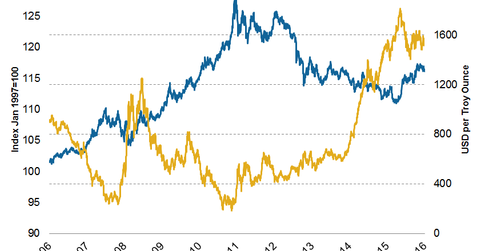How Did the Dollar’s Move Affect the Price of Gold?
Gold is valued in dollars. As a result, the stronger dollar, driven by the recovery of the US economy, is pushing the gold prices further down.
Sep. 23 2016, Updated 10:05 a.m. ET

Market Realist – How the dollar has been impacted over the years
Gold is valued in dollars. As a result, the stronger dollar, driven by the recovery of the US economy, is pushing the gold prices further down. Dollar prices had gained 8.7% YTD on December 31, 2008. The prices recorded a dip of 7.1% YTD on December 31, 2007, and continued the trend until August 2008.
Finally, the dollar started gaining from September due to the first quantitative easing by the Federal Reserve and the fall in currencies of the other economies. The price of the dollar started falling again in May 2009, dipping 5.2% YTD on December 31, 2009. This was the effect of the near-zero Fed interest rates, which aimed to bring down the value of the dollar.
The dollar prices dipped 2.2% YTD on December 30, 2010, after a rebound due to the second quantitative easing. The prices gained 2.3% YTD on December 30, 2011, before dipping until September. Dollar prices dipped 0.7% YTD on December 31, 2012, after a rebound as the Fed introduced the third quantitative easing.
The dollar gained 3.1% YTD on December 31, 2013, due to the pessimistic outlook of China, Japan, and Europe, which bolstered the position of the dollar as the most stable currency. The Fed’s comments regarding the reduction of its quantitative easing purchase toward the end of 2013 further impacted the other currencies. This reinforced the position of the dollar as the strongest currency.
Dollar prices had gained 8.7% YTD on December 30, 2014. The gain in the dollar’s price was driven by reassurance from the Fed regarding quantitative easing, the wave of an upcoming hike in the Fed rates in 2015, and the fall in global oil prices.
Falling global oil prices led to wide fluctuations in the currencies of oil-exporting nations, which further strengthened the dollar’s price. The dollar’s price had recorded a year-over-year growth of 13% in the last week of 2014, which was a record high.
The dollar’s price had increased 10.1% YTD on December 30, 2015. This rise in the dollar’s price was driven by the expectation and the occurrence of the quantitative easing by the ECB and other central banks. As a result, the euro, the yen, and other major currencies stumbled against the dollar.
The dollar’s price had dropped 2% YTD on September 9, 2016, after dropping since early February 2016. The weakening of dollar was due to the overcautious approach toward the Fed’s interest rates.
The PowerShares DB US Dollar Index Bullish ETF (UUP) and the WisdomTree Bloomberg US Dollar Bullish ETF (USDU) fell more than 3% YTD. The PowerShares DB US Dollar Index Bearish ETF (UDN) rose 0.2% YTD in 2016. The PowerShares DB Gold ETF (DGL) and the VanEck Merk Gold Trust ETF (OUNZ) jumped 22.4% and 23.4% YTD, respectively, in 2016.
